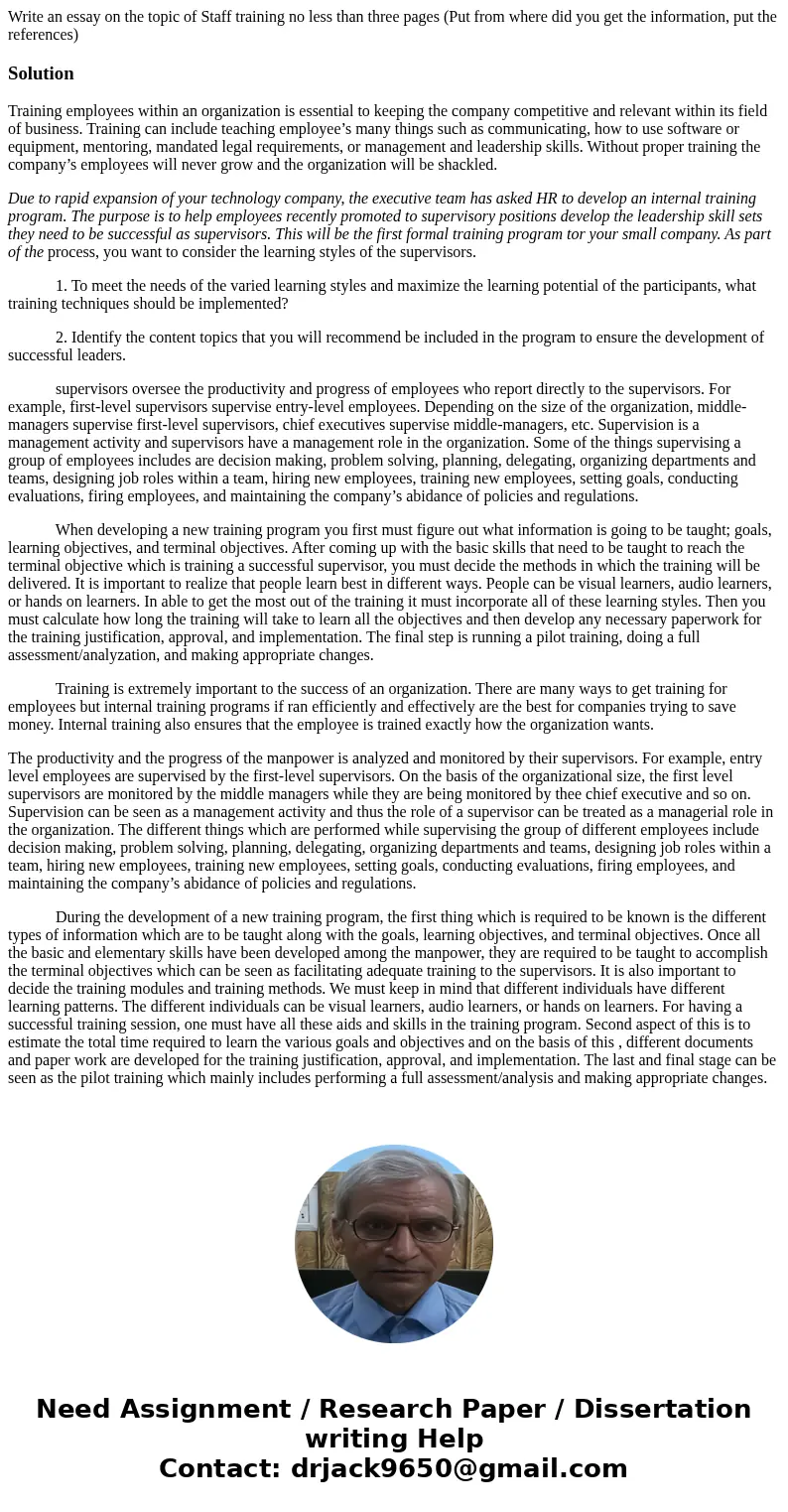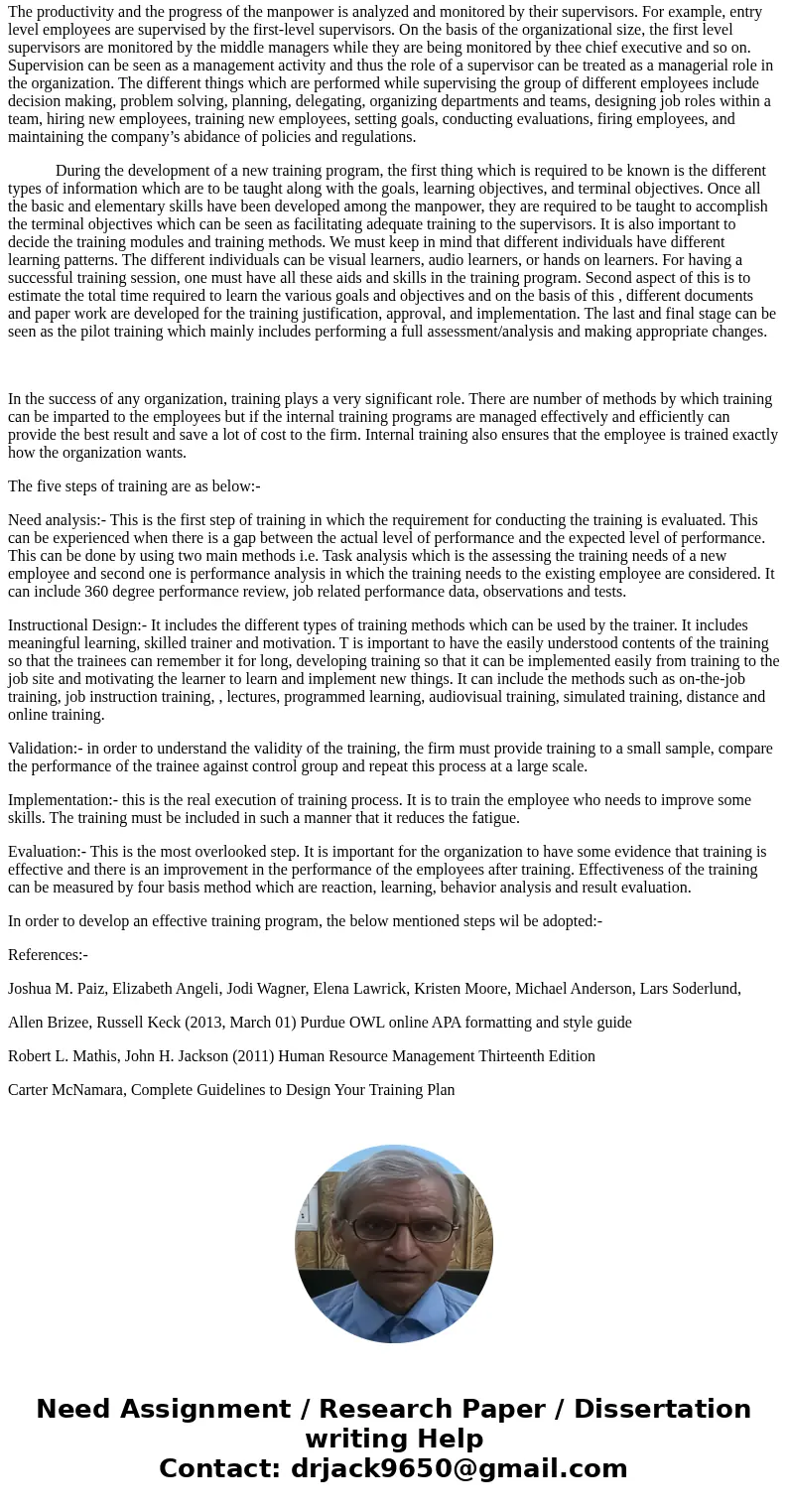Write an essay on the topic of Staff training no less than t
Write an essay on the topic of Staff training no less than three pages (Put from where did you get the information, put the references)
Solution
Training employees within an organization is essential to keeping the company competitive and relevant within its field of business. Training can include teaching employee’s many things such as communicating, how to use software or equipment, mentoring, mandated legal requirements, or management and leadership skills. Without proper training the company’s employees will never grow and the organization will be shackled.
Due to rapid expansion of your technology company, the executive team has asked HR to develop an internal training program. The purpose is to help employees recently promoted to supervisory positions develop the leadership skill sets they need to be successful as supervisors. This will be the first formal training program tor your small company. As part of the process, you want to consider the learning styles of the supervisors.
1. To meet the needs of the varied learning styles and maximize the learning potential of the participants, what training techniques should be implemented?
2. Identify the content topics that you will recommend be included in the program to ensure the development of successful leaders.
supervisors oversee the productivity and progress of employees who report directly to the supervisors. For example, first-level supervisors supervise entry-level employees. Depending on the size of the organization, middle-managers supervise first-level supervisors, chief executives supervise middle-managers, etc. Supervision is a management activity and supervisors have a management role in the organization. Some of the things supervising a group of employees includes are decision making, problem solving, planning, delegating, organizing departments and teams, designing job roles within a team, hiring new employees, training new employees, setting goals, conducting evaluations, firing employees, and maintaining the company’s abidance of policies and regulations.
When developing a new training program you first must figure out what information is going to be taught; goals, learning objectives, and terminal objectives. After coming up with the basic skills that need to be taught to reach the terminal objective which is training a successful supervisor, you must decide the methods in which the training will be delivered. It is important to realize that people learn best in different ways. People can be visual learners, audio learners, or hands on learners. In able to get the most out of the training it must incorporate all of these learning styles. Then you must calculate how long the training will take to learn all the objectives and then develop any necessary paperwork for the training justification, approval, and implementation. The final step is running a pilot training, doing a full assessment/analyzation, and making appropriate changes.
Training is extremely important to the success of an organization. There are many ways to get training for employees but internal training programs if ran efficiently and effectively are the best for companies trying to save money. Internal training also ensures that the employee is trained exactly how the organization wants.
The productivity and the progress of the manpower is analyzed and monitored by their supervisors. For example, entry level employees are supervised by the first-level supervisors. On the basis of the organizational size, the first level supervisors are monitored by the middle managers while they are being monitored by thee chief executive and so on. Supervision can be seen as a management activity and thus the role of a supervisor can be treated as a managerial role in the organization. The different things which are performed while supervising the group of different employees include decision making, problem solving, planning, delegating, organizing departments and teams, designing job roles within a team, hiring new employees, training new employees, setting goals, conducting evaluations, firing employees, and maintaining the company’s abidance of policies and regulations.
During the development of a new training program, the first thing which is required to be known is the different types of information which are to be taught along with the goals, learning objectives, and terminal objectives. Once all the basic and elementary skills have been developed among the manpower, they are required to be taught to accomplish the terminal objectives which can be seen as facilitating adequate training to the supervisors. It is also important to decide the training modules and training methods. We must keep in mind that different individuals have different learning patterns. The different individuals can be visual learners, audio learners, or hands on learners. For having a successful training session, one must have all these aids and skills in the training program. Second aspect of this is to estimate the total time required to learn the various goals and objectives and on the basis of this , different documents and paper work are developed for the training justification, approval, and implementation. The last and final stage can be seen as the pilot training which mainly includes performing a full assessment/analysis and making appropriate changes.
In the success of any organization, training plays a very significant role. There are number of methods by which training can be imparted to the employees but if the internal training programs are managed effectively and efficiently can provide the best result and save a lot of cost to the firm. Internal training also ensures that the employee is trained exactly how the organization wants.
The five steps of training are as below:-
Need analysis:- This is the first step of training in which the requirement for conducting the training is evaluated. This can be experienced when there is a gap between the actual level of performance and the expected level of performance. This can be done by using two main methods i.e. Task analysis which is the assessing the training needs of a new employee and second one is performance analysis in which the training needs to the existing employee are considered. It can include 360 degree performance review, job related performance data, observations and tests.
Instructional Design:- It includes the different types of training methods which can be used by the trainer. It includes meaningful learning, skilled trainer and motivation. T is important to have the easily understood contents of the training so that the trainees can remember it for long, developing training so that it can be implemented easily from training to the job site and motivating the learner to learn and implement new things. It can include the methods such as on-the-job training, job instruction training, , lectures, programmed learning, audiovisual training, simulated training, distance and online training.
Validation:- in order to understand the validity of the training, the firm must provide training to a small sample, compare the performance of the trainee against control group and repeat this process at a large scale.
Implementation:- this is the real execution of training process. It is to train the employee who needs to improve some skills. The training must be included in such a manner that it reduces the fatigue.
Evaluation:- This is the most overlooked step. It is important for the organization to have some evidence that training is effective and there is an improvement in the performance of the employees after training. Effectiveness of the training can be measured by four basis method which are reaction, learning, behavior analysis and result evaluation.
In order to develop an effective training program, the below mentioned steps wil be adopted:-
References:-
Joshua M. Paiz, Elizabeth Angeli, Jodi Wagner, Elena Lawrick, Kristen Moore, Michael Anderson, Lars Soderlund,
Allen Brizee, Russell Keck (2013, March 01) Purdue OWL online APA formatting and style guide
Robert L. Mathis, John H. Jackson (2011) Human Resource Management Thirteenth Edition
Carter McNamara, Complete Guidelines to Design Your Training Plan


 Homework Sourse
Homework Sourse